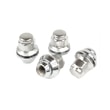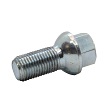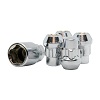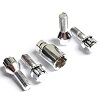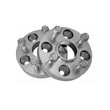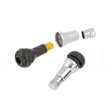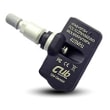Tire pressure - how to check?
The correct pressure in your car's tires is very important and you should therefore check it regularly and very carefully.
What is the easiest and best way to check tire pressure? This is what you will learn in the following points explaining the topic. You will also learn how serious the impact of pressure on driving and accelerated tire wear is.
Why is checking tire pressure important for road safety?
Checking your tire pressure regularly ensures that you are always running on well-inflated tires, which is something you should always take care of. With the wrong pressure - especially too low - driving a vehicle means significantly less safety on the road. The most dangerous is the extension of the braking distance, as well as the reduction of the speed at which aquaplaning occurs. Colloquially referred to as entering water, the phenomenon of aquaplaning leads to a complete loss of control over the car. An underinflated tire also heats up faster, which can cause it to blow up. All these phenomena depend on the quality of the tire, which is why it is worth ordering tires from the best manufacturers by choosing proven models such as Bridgestone Potenza S001.
How to check tire pressure?
There are several ways to check your tire pressure, depending on where you want to do it and what equipment you have.
Using a manometer
A simple pressure gauge, also known as a tire pressure gauge, can be purchased at any automotive store or hypermarket and at petrol stations. It is put on the valve in the wheel and reads the result from the analog scale or it is shown on the digital display. The cost of such a device, depending on its class and manufacturer, is several dozen or one hundred and several dozen zlotys - although a much more expensive model is also available, intended for workshops or servicing large fleets of vehicles.
Use of pressure gauges
It is even easier to check the tire pressure using a system equipped with pressure sensors embedded in the tires. Then you simply read the values on the car's display. When the pressure exceeds the set range down or up, a warning message should also appear on it. If you change tires and you need to replace such sensors with new ones or you have changed their location to a different tire, you may need a specialized TPMS programmer to properly pair them with the car. Thanks to it, you will be able to carry out this activity yourself without visiting a specialist facility.
Use of a gas station
At every good gas station there are compressors for inflating tires, which are equipped with pressure gauges. It is a convenient way to make sure, for example on the road, that everything is in order and that the correct tire pressure is maintained and that it is completely safe to continue driving.

What is the correct tire pressure?
Each tire has a maximum operating pressure - you will find it on the sidewall of the tyre. However, this is a value that must not be exceeded, and not the one that will work best. You can find this information in your car's manual or on a plate that is usually mounted on the pillar or on the front door lock, or on the fuel flap. Typically, the standard pressure recommended by manufacturers for passenger vehicles is around 2.2 bar (31.9 PSI, 220 kPa).
How often should tire pressure be checked?
The simplest answer is that tire pressure should be checked regularly. But what exactly does that mean?
Manufacturer's recommendations
For example, the manufacturer of the Dębica Frigo 2 tire recommends checking the tire pressure once a month, and even more often in the winter, when there are large temperature fluctuations.
Periodic pressure check
It is good to follow the manufacturer's recommendations mentioned above to ensure that the vehicle has the correct tire pressure. In addition, it is worth checking the tire pressure before each long journey and in the event of any signs that something may be wrong with the tires.
What are the consequences of incorrect tire pressure?
Incorrect tire pressure has numerous negative consequences.
Safety on the road
The impact of pressure on driving is enormous. The most important threat is the significant extension of the braking distance with too low tire pressure. The precise control of the car is also deteriorated, which causes problems at faster corners. If the tire pressure is equal on both sides, it leads to the vehicle pulling when driving straight and to turning the vehicle when braking hard. All these phenomena are extremely dangerous and can cause very serious accidents.
Uneven tire wear
Uneven tire wear is also caused by different pressures. If, for example, one of them fails to maintain pressure for a long time, it will heat up more and work differently when turning or braking. Too much pressure, on the other hand, leads to greater wear of the tread and abrasion of its central part.
Increased operating costs
Both under-inflated and over-inflated tires affect vehicle operating costs. Too low increases the rolling resistance and thus the fuel consumption or power consumption in electric vehicles. Ensuring proper tire pressure, just like ecodriving, is therefore an ecological activity. Too much pressure may slightly reduce this cost, but it reduces safety and leads to a much faster need to replace expensive tires. The explosion of an over-inflated and overheated tire can have dire consequences.
Decreased driving comfort
Driving comfort is another thing that also depends on whether you have ensured the correct tire pressure of your car - too hard tires mean more vibrations transmitted to the entire vehicle.

How to maintain proper tire pressure?
Maintaining tire pressure is quite simple and consists of a few simple recommendations.
Checking tire pressure regularly
Regularly checking the tire pressure is the simplest and most effective action. You can do this in the various ways outlined above. Keep this in mind, especially when the temperature drops, which has a big impact on tire pressure. The difference between the temperature of plus 20 degrees and minus 30 degrees can mean a drop in tire pressure of 0.5 bar.
Keeping tires tight
The condition of the valves and their covers should also be checked. If water and dirt get into the valve, it may leak. Evaluate the condition of the tire itself and the rim in the same way, because with tubeless tires both of these elements must adhere closely to each other to ensure proper pressure maintenance. Problems with tightness can also result from the wrong choice of tires for the rim - wrong width and a different profile of both of these elements.
Consultation with a car service
If you have any doubts about the tightness of your tires or their condition at all, go to a decent service station that will carry out a professional assessment, make repairs if possible or recommend replacing the tires with new ones, which is often the only way out. Road safety should be a priority and it is not worth saving on this element.
If you are looking for good and cheap tires for your car, check out Nankang tires, which have probably the best price-quality ratio on the market.




 Nowoczesny design
Nowoczesny design Idealne dopasowanie
Idealne dopasowanie Duża wytrzymałość
Duża wytrzymałość Wysyłka gratis w 24h
Wysyłka gratis w 24h
 Indywidualny projekt
Indywidualny projekt Dedykowany opiekun
Dedykowany opiekun
